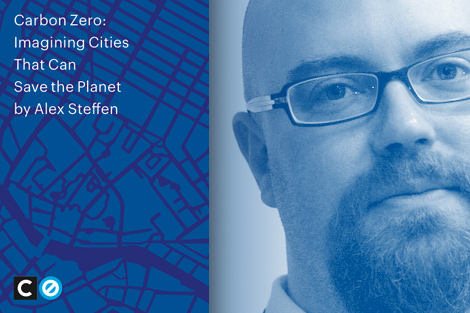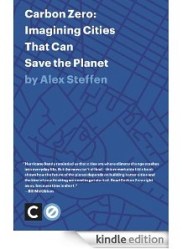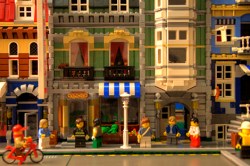 Editor’s note: Welcome to Grist’s presentation of Alex Steffen’s new book Carbon Zero. This is the final installment! Here’s the full table of contents. And this post will tell you a little more about the project. If you like what you read, you can order Carbon Zero from Amazon.
Editor’s note: Welcome to Grist’s presentation of Alex Steffen’s new book Carbon Zero. This is the final installment! Here’s the full table of contents. And this post will tell you a little more about the project. If you like what you read, you can order Carbon Zero from Amazon.
CONCLUSION
Even if we perform great feats of innovation, hard times lie ahead and the impacts of climate change are unlikely to be fair.
History and geography matter. There are some places that are dealing with natural attributes and human legacies that will be almost impossible to address. (Bangladesh, for instance, will find it very hard to adapt to sea-level rise under the best circumstances; many auto-dependent American suburbs will likely experience economic distress as resource and energy costs rise; the U.S. desert Southwest will be extremely stressed by both anticipated heat waves and fossil fuel-dependent land uses and economies.) How temperate the local climate is likely to be, how stable the surrounding ecosystem services are likely to remain, how wise (or lucky) the region has been in growing energy-efficient cities, how rich the local people are, and how much strength and integrity their national governments have — all these factors will matter, undoubtedly.
But I’ve come to the conclusion that readiness to act matters more than any of these. Places that invest boldly in the next decades in ruggedizing their systems, growing civic resilience, and building up the local capacity for innovation, adaptation, and rapid cultural change — these are the places that will find themselves most prepared for the storms on the horizon.
Being a city-region ready to meet the future (whatever it looks like) is more important than being luckiest in location or wealthiest at the moment. Successful engagement with future turmoil will demand leadership, strong civic cultures, commitment to change, tough choices, and aggressive action on changing big systems. No city out there is moving fast enough yet, but some are beginning to show signs of understanding the scope, scale, and speed of the change demanded of them. Others look great now, but are changing only incrementally and slowly. There comes a point where lack of action means further incremental change can no longer keep up with exponential problems.
On the other side of the coin, being a city-region that’s deeply engaged with the work of readiness and ruggedization may give unexpected benefits. Climate adaptation and recovery is going to be one of the 21st century’s biggest industries. Places that invent affordable, effective methods and tools for meeting these challenges aren’t just helping themselves weather the storm, they’re also expanding the range of the possible and quite possibly finding another competitive advantage for their region’s economy.
Personally, I’d rather live in a city that’s moving fast to meet the future than one that started farther ahead, but is stuck and complacent, or simply unwilling to go beyond mere incremental change. If I became confident that any city was indeed poised to be the real global leader, I’d move there in a heartbeat and help any way I could.
I know I’m not alone. In fact, I suspect that a city that really pushed itself to the forefront of urban innovation (and had a clear commitment to further innovation ahead) would find itself a magnet for civic talent, technical genius, entrepreneurial savvy, and global investment. The edge a leading bright green city gains in the next 20 years could put it in a position of increasing prosperity for a century, even in the midst of hard and turbulent times. To prosper while genuinely doing good is something to which we all can proudly aspire.
The best-possible scenario would be one in which many cities hurl themselves into fierce competition to lead in a bright green urban boom. That competition is probably not only the key to creating cities that offer the best, most sustainably prosperous lives possible, but also the best answer we have to the planetary crisis we face. We need a race to carbon zero.
Thinking
To precipitate that race, though, we need first to change the way we think and talk about the climate crisis.
When thinking about climate change, many people quickly find themselves hooked on a sharp snag: Unlike almost every other problem we’re used to dealing with, climate is a matter of absolutes and limits. We’re used to describing our approaches to solutions in terms of relative degrees of improvement: Dropping a few pounds on a diet is better than not losing weight at all; learning some home repair skills is better than not learning at all; reducing childhood poverty by a bit is better not raising the prospects of any children. We’re used to thinking about problems where making things a little better is a success of sorts, or at least an indicator of good intentions.
But climate change is not a problem that responds to marginal improvements. Instead, it is all about the total amount of greenhouse gases in the atmosphere; it is their accumulation that hurls us towards catastrophe, and the degrees of danger associated with that accumulation are out of our control (and only recently within our understanding). Put another way, it doesn’t matter that we’re less polluting than we once were. It doesn’t matter how good we feel about these improvements. The only thing that matters is that aggregate concentration, that parts per million CO2 number.
Because of this, climate change places severe demands on us as intelligent, ethical people. The net elimination of our greenhouse gas emissions is the only sensible goal, and the only really debatable part of that goal is who zeroes-out when. Regardless of where responsibility lands, the goal remains the same — and absolute. Within the lifetimes of many of the people reading this little book, humanity will either bring its climate emissions down to a number in balance with the capacities of the planet (and have begun a worldwide effort to pull carbon out of the atmosphere) or face worsening, destabilizing disasters. Our choice is binary: carbon zero or climate chaos.
Therefore, the type of city I tried to outline here is no utopian ideal. It’s a foil meant for you to use to imagine your own strategy to face up to that stark choice. The changes we need to see demand imagination as a first step, because we lack the example of any city, anywhere, that provides prosperity sustainable enough to meet our challenges. Creating visions of carbon zero cities is therefore anything but an airy intellectual exercise, a design folly, a futures game. It is the first step in designing survival strategies for civilization.
Those visions will need to move quickly to implementation, of course, but without hard, sufficiently ambitious targets, climate planning in even green-minded North American cities quickly becomes an exercise in dressing up existing policies and plans as climate action, making marginal commitments to new efforts, and calling for bold action on time frames that lift the burden of urgent action from the shoulders of anyone now in political office. Unless the target is both defined in a comprehensive way (for instance, a consumption-based approach) and clear in its numbers (for instance, net zero emissions by 2030), it will never serve to force the kind of plans and policies carbon zero cities require. That may seem hard to imagine now, but that’s precisely why we need to begin with the work of imagination.
Such imaginative work must transcend the prescriptive, though. The possibilities of a world of carbon zero cities are just as hard for most people to envision as the plans, policies, technologies, and systems that will make those cities possible.
Almost everything we need to do to reduce urban emissions will provide most people with better cities than they have today, with a quality of life better than the one they currently enjoy. Done right, life will simply be better — measured by health, safety, security, prosperity, life experiences, and effective wealth-building — for most people in carbon zero cities. Indeed, the big open secret about urban climate action is not how bad things are — it is how good things can get.
While the struggle to build those cities is first and foremost a struggle of vision — we can’t build what we can’t imagine — it won’t be fought in make-believe places or involve theoretical people. It will happen in the real world, led by real people.
The city in which you’re reading this is a carbon zero city in the making. It just doesn’t know it yet. It needs your creativity and applied imagination to show it what it is; to show it its future.
— Seattle, June 2012





